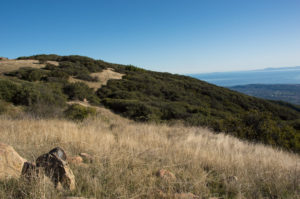The Wrong Approach for Chaparral
The Los Padres National Forest and the surrounding region is predominantly covered with chaparral. To understand why prescribed fire is ineffective and can actually be harmful to native chaparral ecosystems, it is important to first understand the issue of type conversion. Simply put, type conversion is the replacement of native chaparral with nonnative grasses and weeds. A major cause of type conversion in our region is overly-frequent fire.
Chaparral Loss to Frequent Fire
Before humans settled along the central and south coasts of California, chaparral had evolved adaptations to a specific fire regime. Areas would burn every 30 – 150 years depending on the frequency of lightning — the only natural source of wildfire ignition. Wildfires here are naturally intense crown fires, meaning they burn all above-ground vegetation. Between fires, chaparral species had ample time to grow to maturity and produce enough seed to recolonize an area after the next fire. As humans settled these areas, they began setting fires intentionally and unintentionally, and at a greater frequency than species were adapted. This has resulted in less time between fires for plants to grow to maturity and produce seed. As fires burn the same area more frequently than every 30 years or more, that area becomes more susceptible to nonnative species dominating since the native chaparral seedbank is depleted.
The Ineffectiveness of Prescribed Fire

Type-converted fuelbreak in the Santa Ynez Mountains. This area has had prescribed burns and repeated bulldozing over the years. The chaparral has been replaced with black mustard and nonnative grasses. Note the encroachment of the type conversion into the chaparral in the background.
Prescribed fire only exacerbates the type conversion process and doesn’t necessarily reduce an area’s risk of burning later, with studies concluding that it is not a cost-effective method in chaparral. This can be easily seen by overlapping wildfire burn areas in and around the Los Padres National Forest. For example, the 2017 Thomas Fire burned most of the areas burned by 1985’s Wheeler and Ferndale Fires, areas burned by the 2003 Piru Fire and 2006 Day Fire, and canyons that burned in the 2008 Tea Fire and 2009 Jesusita Fire. The 2016 Soberanes Fire burned over half of the area burned by the 2008 Basin Complex Fire in the Monterey Ranger District. The recent Thomas Fire also burned through several prescribed burns that had been conducted near Ventura. Prescribed burns in chaparral would probably have to be conducted very frequently (every five years or less) in order to be effective, and as described above, overly-frequent fire in chaparral can have serious environmental consequences.
The timing of prescribed burns is also of concern to fire scientists. Prescribed burns must be conducted during a narrow window in order to be successful due to vegetation moisture levels and weather conditions, meaning they are often done in winter or spring when many wildlife species are breeding and birds are nesting in the area. Prescribed burns during this time may heat up the moist soil to the point that seeds are damaged by the resulting steam. Conversely, these fires may not burn hot enough to stimulate native seed germination. For example, many native ceanothus species require high heat to crack their seed coat and allow germination. Lower temperature fires—which may intuitively seem like a good thing—have actually been shown to reduce ceanothus and other similar seed germination. And there is always the risk of prescribed burns escaping and becoming full-fledged wildfires.
Indigenous Use of Prescribed Fire
There is evidence that Native Americans used prescribed fire along the central coast before Europeans settled in our region. However, researchers have determined prescribed fire was being used to purposefully convert chaparral to grasslands —primarily along coastal plains and inland valleys—to allow for movement across the landscape, the creation of open hunting areas, the selection of edible herbaceous plants, and the reduction of habitat for potentially dangerous predators such as grizzlies — not to reduce the incidence of large wildfires. In fact, large landscape-scale fires still occurred prior to the European invasion. These areas tended to be highly localized, indicating that indigenous peoples in the region used fire very thoughtfully rather than burning the landscape indiscriminately. Many of the areas that were converted from chaparral to native grassland were then claimed by European colonizers to be used for non-native cattle grazing. American ranchers later expanded these areas through indiscriminate use of frequent fire, which likely led to large losses of chaparral in the 19th and early 20th centuries. Unlike the native grasses and herbs that grew in the chaparral’s place when Native Americans type converted areas, today type conversion results in the spread of non-native species such as black mustard and highly flammable cheatgrass. These species actually pose a greater wildfire risk as they dry out earlier in the year, ignite more easily, and spread wildfire more quickly than chaparral.
Approaches That Work
So, with the concerns and challenges surrounding prescribed burning, is there a more effective way to protect our communities from wildfire? Scientists and fire ecologists agree that the most effective ways to protect communities involve fire-proofing structures, creating smart defensible space around homes, and rethinking where and how we build in fire-prone areas. For more, check out our fire page.






